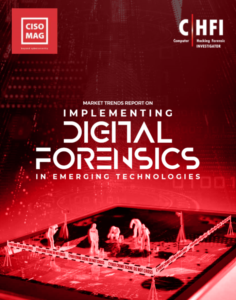
Computer Forensics is now known as Digital Forensics and the task of uncovering digital evidence is more challenging than ever. It now involves governments and multiple jurisdictions. Today, forensic experts would need to travel to different countries to find digital evidence, as cybercrime is performed across borders. And emerging technologies like blockchain are making the task more difficult.
In pursuit of finding digital evidence, forensics experts would be led to the Dark Web, which is akin to going underground, incognito, to look for criminals and to find clues.
The explosion of data and the growing number of mobile phones and IoT devices also pose challenges. And if the digital evidence is on a cloud service provider’s platform, investigators would need a warrant from the court to access it.
Emerging technologies and borderless cybercrime have made Digital Forensics more challenging than ever.
So how do we counter all this with a completely different strategy?
 To better understand the challenges and state of readiness in implementing Digital Forensics in emerging technologies, CISO MAG, in collaboration with EC-Council’s CHFI (Computer Hacking and Forensic Investigation), launched a Technology Trends Survey in April 2021. The report offers an in-depth analysis of how important it is to incorporate the effects of digital forensics on emerging technologies into the curriculum of digital forensic education.
To better understand the challenges and state of readiness in implementing Digital Forensics in emerging technologies, CISO MAG, in collaboration with EC-Council’s CHFI (Computer Hacking and Forensic Investigation), launched a Technology Trends Survey in April 2021. The report offers an in-depth analysis of how important it is to incorporate the effects of digital forensics on emerging technologies into the curriculum of digital forensic education.
This survey is oriented towards skills, training and industry opportunities, specifically for digital forensics. The aim of this survey is to better understand the forensic readiness and challenges of implementing digital forensics in emerging technologies. The widespread adoption of technologies such as the Internet of Things (IoT), cloud computing, mobile and web applications has changed the way data is being processed and stored. From the perspective of cybersecurity education in digital forensics, this survey attempts to gauge the upcoming challenges that will arise upon the deeper integration of digital forensics with these technologies.
This exclusive report based on the survey showcases the viewpoints of industry experts and their perspectives from across the table.
Key findings
- 94.83% of the respondents believe that cloud computing technology and its corresponding cloud forensics will have a greater impact on digital forensics education in the future.
- 60.51% of the respondents feel that gaining evidence files of around 50 GB for digital forensics study and research, will be extensively or quite helpful, as there is a general lack of high-volume data in forensics for the purpose of study and practice.
- 52.40% of the respondents believe that smartphones connected to, or as an IoT device will be the most challenging while performing IoT forensics.
- 39.11% of the respondents believe that performing forensics of a network is the most challenging task when conducting TOR forensics.
- 86.72% of the respondents believe that analyzing and decrypting will be the widely used methods for dealing with the anti-forensics technique of encryption.

To view the complete analysis and reportage, hit the download button now!










